Château Ducru-Beaucaillou Revisited
by mimithorisson
I first heard about Bruno Borie from an English gentlemen who had invited me for a cup of coffee in Pauillac. A wine merchant who was visiting Médoc and wanted to explore the possibilities of working together on a project. It was close to noon and as we discussed his trip, people he had met, wine he had tried, he leaned over and admitted that for all the amazing things, dinners and lunches he’d had on his voyage, the one he was most excited about was the one coming up an hour later. An intimate little lunch, cooked and served in the kitchen of Château Ducru-Beaucaillou by the master of the house, Mr. Bruno Borie. He was beaming with excitement. Later when he met my husband in London he confessed that the lunch had more than lived up to its billing, the highlight of a spectacular Médoc visit.
All this piqued my interest and aroused my culinary curiosity. I was, of course, very familiar with the wines of Ducru-Beaucaillou, some of the best and most respected in the world, but I knew little about the famous grounds or the people living there. A few weeks later, passing through St Julien, I suggested a quick unannounced visit to the château. We trespassed a little bit (as we often do) drove sneakily around, admired the gardens from afar. Oddur wanted to take pictures as he always does, I (as usual) thought it better to get permission. I entered through a door at the side of the château, into something that looked like offices. I introduced myself but was told that the owner of Ducru-Beaucaillou wasn’t there that day and only he could grant such permissions. Oddur was eager to explore, from afar we could hear the barking of dogs, it was all so interesting and inviting but on that day, unfortunately, forbidden. As we were driving away I looked out the rear window, at the château disappearing behind us and I wondered, “where in that grand building would one put a kitchen, was it on the top floor, in the main building, in either of the wings?” Perhaps I would never know.
A few months later a famous oenologist introduced me to his neighbor, a real Médocain character by the name of Yves Lajoux. We went fishing together, he showed us the best hunting spots and finally he wanted to take us to the finest château in Médoc, where he had worked all his life before he retired. You don’t have to be very smart to know what château he was talking about, it fits right into my story. Mr. Lajoux showed us the very impressive grounds (he said he didn’t really need permission) and later insisted that we meet his former boss, a real renaissance man who hunts, cooks and loves his region. Mr. Borie was extremely welcoming, and greeted us on the doorsteps of the château. We discussed cooking, bien sûr, there was some wine talk, but mainly we talked about food. I remember Mr. Borie saying that good food and good wine could not exist without each other, an argument I happen to agree with. We debated on the best way to prepare a mullet fish carpaccio (a local speciality), on our favorite ways to cook a rabbit. It was decided that we would cook together in the fall, in his red kitchen. Mr. Lajoux was given the task of getting a rabbit and we said our goodbyes. I almost asked for a tour of the kitchen but my repressed French manners got the better of me.
As it often is, even with the best intentions, some plans, great as they may be never get to be more than plans. They are never executed, they never see the light of day. Somehow autumn came and went, there was no rabbit, no red kitchen. I often wondered, passing through St Julien about this missed opportunity, this wasted chance. Would I ever get to see the inside of that château?
And then it happened. Reintroduced by a friend, Borie and I decided to make up for lost time and cook together the feast of feasts, something grand to celebrate the holiday season, to help bring in the new year. It was a case of “I was waiting for you to call me … really, I was waiting for you to call me!”
So one glorious day in late November, the vineyards still teeming with golden leaves that have now gone, the gardens of Château Ducru-Beaucaillou at their most beautiful autumn splendor we set up shop in that famous red kitchen and started cooking up a feast. The day began with Bruno getting some vegetables from his private garden and introducing us to his dogs (my husband’s favorite part). They are English setters that he says are very loyal to him, especially a young female of exceptional hunting prowess, Finette, who will have nothing to do with anyone but her master. He showed us all the trees he’s been planting in the last few years, some very exotic varieties that he’s bought at auctions and even special little trees for attracting birds so he can teach his 6-year-old son, Louis, how to hunt. He has even planted a whole forest for his young son, what are now just little plants will have grown into thick woods when the boy turns 30 – I must say I find that very romantic. Planting trees for a person you love or for any reason is always a good idea.
After our walk we started chopping away, sautéing, wrapping the pigeons with fat… lots of serious old-fashioned cooking going on. In making the foie gras terrine we started by smoking it on the sarment vines, outdoors, just by the golden vineyards. This technique was certainly a first for me. The chanterelles that Bruno had picked up himself on a recent trip to Brittany were ready to be sautééd in his glistening copper pans. It was, let’s say, a perfect cooking day for me!
When you spend the better part of a day cooking a glorious feast you might as well enjoy the moment and dress for the occasion. I must confess (well you can see it in the photos) that the grandeur of the château inspired me to wear my heels all day (a girl can cook all day and still feel glamorous). When it was time to sit down and enjoy it all Bruno and I felt we needed to up our game and put on our finest attire.
New Year’s eve should always be a black tie event – even in November.
It was Bruno who came up with the menu we cooked, a feast of all his favorite things, cooked his way, in his kitchen. He wanted to prepare a menu of the food he loves, fit for the occasion and for his wine. Each course paired perfectly with various wines and vintages he chose from the family’s estates. It’s meant to be a little holiday treat for his clients and my readers – I sincerely hope that our day of cooking will inspire you to cook a feast of your own with your own versions of these recipes. As I have said somewhere before, there is dinner and a show … and then there are moments when the dinner IS the show!
As I was sitting there, taking the last sip of the 1982 Ducru-Beaucaillou, inside the very château that’s illustrated on the bottle I thought to myself “things just don’t get much better than this”, it was one of those moments where you think that you might never get to have that feeling again. But it seems I’m in luck. Bruno has challenged me to another cooking session in the new year, this time I have to come up with all the dishes. So as they say on TV … to be continued.
Bruno Borie’s New Year’s Eve Dinner Menu
Pumpkin soup with chestnuts and fresh foie gras
Terrine of foie gras grilled on cabernet vine shoots, red wine of Médoc jelly, root vegetables with truffle oil
Cordouan blue lobster stew with red wine of Médoc
Pigeon “Woodcock” Style
Braised green cabbage
My Grandmother’s Chestnut Cake with custard
Pumpkin soup with chestnuts and fresh foie gras
(Can be prepared the day before)
For this soup, we served it in a large pumpkin. Just carve the top hat of the pumpkin, scoop out and reserve the flesh.
Ingredients:
1 large pumpkin
1 large onion, sliced finely
1 liter/1 quart chicken stock
A few cooked chestnuts, coarsely chopped
1/4 tsp ground nutmed or grated
A slice of foie gras (optional)
4 tablespoons olive oil
A dash of piment d’Espelette
A few sprigs of chive, chopped finely
Salt and freshly ground black pepper
Heat olive oil in a large pot, sauté the onions for a few minutes on a medium heat, add the pumpkin chunks and continue to cook for a few minutes. Pour the stock, season with salt and pepper and bring to a simmer. Cover with a lid and leave to cook for 5 minutes, or until pumpkin is tender and cooked through. Blend with a stick blender, adjust the seasoning, add a dash of piment d’Espelette to your taste and grate some nutmeg. Set aside.
Cut the cooked chestnuts into 4 or 6 pieces.
Cut up a generous slice of foie gras into small cubes, heat a sauté pan on a high heat. Once the pan is sizzling hot, sauté the foie gras cubes so they are golden brown on all sides – this should take less than a minute as you don’t want the cubes to overcook or melt.
Just before serving, heat the soup. Serve the soup, garnish with a few bits of chestnut and cubes of foie gras; add snippets of chives as a final decorative touch.
Terrine of foie gras grilled on cabernet vine shoots, red wine of Médoc jelly, root vegetables with truffle oil
(To be prepared 36 to 48 hours in advance)
Ingredients:
1 foie gras liver, approximately 500 to 600 g/ 1 to 1 1 1/4 pounds
1 leek
2 carrots
1 onion
6 cloves
2 cloves of garlic
1 shallot
1 bouquet garni
Salt & freshly ground black pepper
For the red wine jelly
500ml/ 2 cups red wine from Médoc
2 sheets of gelatin
Place the foie gras in icy water, open and devein carefully.
Light the cabernet vine cuttings and wait for the embers to be slightly covered with ash. Place the foie gras on the grill above the embers to both sear and smoke it at the same time. Once it’s golden-brown on all sides, take it back to the kitchen, season with salt and pepper and vacuum-wrap. Place the vacuum-wrapped foie gras in a baking dish and fill halfway with room temperature water and cook in a preheated oven for 1 hour at 60°C (14o°F) au’bain-marie’ (water-bath).
Leave to cool completely.
Pour the red wine in a saucepan. Add the sliced leeks, carrots, onions pierced with cloves, garlic, shallots and a bouquet-garni. Cook on a medium heat and leave to simmer.
Flambé the wine for a few minutes. Pour the wine through a sieve, salt and pepper to taste and add the necessary amounts of gelatin sheets (add+25% more because of the wine). Leave to cool.
Open the vacuum-wrapped foie gras, place in a terrine dish, pour the cooled red wine jelly mixture on top until completely covered. Cover the top with a plastic wrap, cover with a lid and leave to set in the refrigerator for 24 to 48 hours before serving.
For the side dish:
A mixture of root vegetable, all peeled and chopped into small 1/2 inch cubes
1 small truffle
Olive oil
A few sprigs of chives
Salt and freshly ground black pepper
Peel and chop up root vegetables, such as carrots, salsify, raves, celery, parsnips … blanch them for a few minutes in salted water, then set aside and keep cool. An hour or two before serving, season with olive oil, a truffle chopped into tiny cubes, salt, pepper and chives.
Cordouan blue lobster stew with red wine of Médoc
(the broth can be prepared the day before)
Ingredients:
For this recipe, prepare a red wine fish stock in advance.
2 lobsters, approx 500-600g/ 1 to 1&1/4 pound each
1 bottle of Médoc red wine
Olive oil
A dash of piment d’Espelette
Salt and freshly ground black pepper
Prepare a fish stock with red wine (preferably of Médoc). Using fish bones, heads and skin, add a bay leaf, a stalk of celery, a few branches of parsley, 1 carrot, 1 onion, salt & pepper. Instead of using water, use red wine. Cook for 20 to 30 minutes and drain through a sieve.
Chop up the lobster into thick slices. Sear the slices quickly in a drizzle of olive oil, salt and spice with piment d’Espelette for a few minutes.
Place the lobster in a casserole dish, cover with the red wine fish stock and place in the oven at 60°C (140°F) for 1 hour.
Pigeon “Woodcock” Style
(To be prepared the day of serving)
For 4-6 pigeons (depending on size).
4-6 pigeons (keep the livers, hearts and gizzards)
4-6 fatback slices to wrap the pigeons
6 generous slices of country bread
80 g/ approx. 3 ounces de Bayonne ham
1 shallot
Unsalted butter
1 tablespoon Cognac
3 tablespoons Madera wine
1 teaspoon whole grain mustard
1 teaspoon juniper grains
5 tablespoons of red wine game stock
Salt and freshly ground black pepepr
For the sauce
1 shallot
80 g/ approx. 3 ounces Bayonne ham
1 slice of foie gras
Red wine game stock
1 teaspoon juniper grains
1 teaspoon mustard
3 tablespoons Madera wine
1 tablespoon Cognac
1 bouquet garni
A dash of piment d’Espelette
Salt and freshly ground black pepper
Prepare the pigeons: Remove all the feathers. Gut them and put aside the livers, hearts and gizzards. Salt and pepper, wrap the pigeons in a strip of lard, and then truss them.
In a large dutch oven, heat 2 to 3 tablespoons of olive oil on a high heat and cook the pigeons on all sides until golden brown. Turn down the heat to medium low and leave them to cook, turning them occasionally, for about 25 minutes, or until cooked through (to your desired cuisson).
Giblet paste for the toasts
Carefully clean the giblets (remove the internal skin from the gizzards), finely chop them along with a few cubes of Bayonne ham. Salt and pepper. Sauté a shallot in butter, add the mince, cook it all together then add one generous shot of Armagnac or Cognac and three of Madeira. Add a rounded teaspoon of whole-grain mustard, a few grains of juniper and a ladle of the red-wine game stock. Let simmer gently on the stove. Spread thick slices of good country bread with butter and grill them on a pan. When ready to serve spread a generous layer on the grilled bread.
For the sauce
Sauté the shallot with the diced Bayonne ham and a generous slice of foie gras cut into cubes. Pour a large cup of red-wine game stock, add a few grains of juniper, one teaspoon of whole-grain mustard, 3 shots of Madeira and
1 of Armagnac or Cognac, a bouquet-garni, a few grains of juniper and a pinch of Piment d’Espelette. Leave to a simmer for 1 hour, and blend (with a stick blender) after removing the bouquet-garni. Adjust the salt and pepper and drizzle the pigeons previously placed on the toasts.
Braised green cabbage
(you can prepare this side dish the day before)
Ingredients:
1 Savoy cabbage
1 onion, sliced
1 shallot, sliced
1 large carrot, sliced
1 slice unsmoked pancetta, sliced into chunky match sticks
1 glass white wine
A few grains of juniper, coriander and cumin
Salt and freshly ground black pepper
Blanch the cabbage leaves in simmering water.
Remove the spines and cut up the leaves coarsely. In a pot sauté an onion, a shallot, carrots and a dice up a generous slice of unsmoked pancetta.
Add the cabbage and a glass of white wine. Put in a few grains of juniper, coriander and cumin. Add an onion pierced with 3 cloves and grate a bit of nutmeg.
Stir everything, cover and leave to cook gently on the stove for 20 to 30 minutes.
My Grandmother’s Chestnut Cake with custard
(Prepare 48 hours ahead)
1 kilo/ approx 2 pounds of unsweetened chestnuts peeled, blanched and pureed
250 g/ 2 1 1/2 cups of confectioner’s sugar
100 g/ 1/2 cup of granulated sugar
150 g/ 2/3 cup of butter
350 g 12 ounces Venezuelan dark chocolate
A shot of rum or Cognac, optional
Melt the chocolate in a double-boiler over simmering water, add the butter and both sugar. Mix together with the chestnuts (previously pureed) to a medium texture.
Add a shot of Martinique dark rum or good Cognac – this step is optional.
Place the mixture in cake tins (for this recipe, we used canelés ramekins in silicone, as it is easier for unmoulding). Leave them in the refrigerator for 24 to 48 hours before serving. Take the cakes out of the ramekins and serve with a crème anglaise (you can find the crème Anglaise recipe here).
Recettes en Français:
Dîner du Nouvel An de Bruno Borie
Soupe de citrouille aux châtaignes et foie gras frais
Terrine de foie gras grillé aux sarments de cabernet, gelée au vin de médoc, racines anciennes à l’huile truffée
Civet de Homard bleu de Cordouan au vin rouge de Médoc
Pigeon façon bécasse
Choux vert braisé
Gâteau aux châtaignes de ma Grand-Mère
Crème anglaise
Soupe de citrouille aux châtaignes et foie gras frais
(Peut-être préparé la veille)
Ingrédients:
1 oignon
1 citrouille (pour environ 1 kg de chair)
1 litre bouillon de volaille
Piment d’Espelette
Noix de muscade, rapée
Quelques chataîgnes, coupées en 4 ou 6 morceaux
Une belle tranche de foie gras, coupée en cubes
Quelques brins de ciboulette
Huile d’olive
Sel et poivre
Emincez un oignon, le faire fondre dans un peu d’huile d’olive, rajoutez la citrouille coupée en gros cubes, faire suer le tout, couvrir avec de l’eau et du brouillon de volaille, saler.
Quand la citrouille est cuite, mixez le tout, ajustez le sel, rajoutez du piment d’Espelette en poudre jusqu’à votre goût, râpez un peu de noix de muscade.
Epluchez quelques châtaignes, les blanchir, les couper en 4 ou 6 morceaux.
Détaillez une belle tranche de foie gras frais en petits cubes, les poêler très rapidement pour garder leur moelleux.
Au moment de servir donnez un bouillon à la soupe et garnissez chaque assiette. Posez dans chacune quelques morceaux de châtaignes et dés de foie gras ; décorez avec une tombée de ciboulette ciselée.
Terrine de foie gras grillé aux sarments de cabernet, gelée au vin de médoc, racines anciennes à l’huile truffée
(A préparer 36 à 48 heures à l’avance)
Ingrédients:
Un foie gras entier, environ 500 à 600 g
Vin rouge du Médoc
1 ou 2 poireaux
1 carotte
1 oignon piqué de clou de girofle
1 gousse d’ aïl
2 échalotes
1 bouquet garni
Sel et poivre
Pour la garniture:
1 truffe noire
2 carottes
1 salsifi
2 raves
1 branche de céleri
1 panais
Quelques brins de ciboulette
Huile d’olive
Sel et poivre
Placez le foie gras dans de l’eau glacée, l’ouvrir et ôtez les veines avec précaution.
Allumez les sarments de vigne. Attendre que les braises soient légèrement couvertes de cendres. Placez le foie gras sur le grill au-dessus de votre braise. Le faire à la fois saisir et fumer. Dès que vous l’aurez doré sur toutes les faces, ramenez-le en cuisine, salez et poivrez, roulez-le dans du film alimentaire et le mettre sous vide avant de le cuire au bain marie, 1 heure à 60°.
Le refroidir.
Faites infuser dans du vin rouge du Médoc une garniture aromatique composée de poireaux, de carottes, d’oignons piqués de clou de girofle, d’ail, d’échalotes et un bouquet garni.
Faites chauffer le tout et maintenez une température frémissante.
Faites bruler le vin en plaçant une flamme au-dessus de la casserole frémissante jusqu’à ce que l’alcool soit évaporé. Passez le vin, ajustez sel et poivre et rajoutez la quantité de feuilles gélatines nécessaire (+25% à cause du vin). Laissez refroidir.
Placer le foie gras dans la terrine et le recouvrir de la gelée au vin rouge.
Epluchez et détaillez des racines anciennes tel: carottes, salsifis, raves, céleri, panais, etc…les blanchir à l’eau salée, réservez-les au frais. Une ou deux heures avant le service, assaisonnez-les avec de l’huile d’olive, une truffe détaillée en petits dés, sel, poivre et ciboulette.
Civet de Homard bleu de Cordouan au vin rouge de Médoc
(Le fumet peut être fait la veille)
Ingrédients:
2 Homards bleus
1 bouteille de vin rouge du Médoc
Huile d’olive
Piment d’Espelette
Sel et poivre
Préparez un fond de poisson avec du vin rouge du Médoc. (Parures de poisson, carottes, oignons, poireaux, bouquet garni)
Détaillez le homard en petits tronçons. Faites saisir rapidement les morceaux dans un filet de l’huile d’olive, salez et épicez avec du piment d’Espelette.
Placez le homard dans une cocotte, recouvrez-le avec le fond de vin rouge et laissez le tout au four à 60°C pendant 1 heure.
Pigeon façon bécasse
(À préparer le jour même)
4-6 pigeons – selon la taille (gardez les foies, les coeurs et les gésiers)
De la barde de lard (pour chaque pigeon)
Sel et poivre
6 belles tranches de pain de campagne
80 g de jambon de Bayonne
1 échalote
Beurre doux
1 cuillère à soupe de Cognac
3 cuillères à soupe de vin de Madère
1 cuillère à café de moutarde
Quelques grains de baie de genièvre
Une louche de fond de gibier au vin rouge
Pour la sauce
1 échalote
80 g de jambon de Bayonne
1 tranche de foie gras
Fond de gibier au vin rouge
Quelques grains de genièvre
1 cuillère à café de moutarde à l’ancienne
3 cuillères à soupe de vin de Madère
1 cuillère à soupe de Cognac
1 bouquet garni
Quelques grains de baies de genièvre
Une pincée de piment d’Espelette
Sel et poivre
Bien parer les pigeons : ôter toutes les plumes avec attention, vider en gardant les foies, les cœurs et les gésiers. Salez et poivrez, entourez les pigeons d’une barde de lard, puis troussez-les.
Faites les dorer de toutes les faces avant de les placer dans une cocotte pour finir les cuire à température modérée.
Farce pour le toast
Bien nettoyer les abats (ôtez la peau interne des gésiers), hachez les finement avec quelques dés de jambon de Bayonne. Salez et poivrez. Faites fondre une échalote au beurre, rajoutez le hachis, faites cuire l’ensemble puis rajoutez une bonne tombée de cognac et 3 de vin de Madère. Rajoutez une belle cuillère à café de moutarde à l’ancienne, quelques grains de genièvre et une louche de fond de gibier. Laissez mijoter doucement sur le coin de la cuisinière. Passez de belles tartines de pain de campagne au beurre pour les faire rôtir, et au moment de servir étalez généreusement la farce sur chacune.
Sauce
Faites fondre une échalote avec quelques dés de jambon et une belle tranche de foie gras détaillée en dés. Mouillez avec du fond de gibier au vin rouge, rajoutez quelques grains de genièvre, une cuillère à café de moutarde à l’ancienne, 3 tombées de Madère et une de cognac, bouquet garni, quelques grains de genièvre et une pincée de piment d’Espelette. Laissez frémir pendant 1 heure et mixez après avoir ôté le bouquet garni. Ajustez le sel et le poivre et nappez les pigeons préalablement dressés sur les toasts.
Choux vert braisé
(Peut être préparé la veille)
Ingrédients:
1 chou vert
1 oignon
1 échalote
2 carottes
Une belle tranche de ventrèche sèche
1 verre de vin blanc
Quelques grains de genièvre, coriandre et cumin
1 oignon, piqué de 3 clous de girofle
Noix de muscade, rapée
Sel et poivre
Blanchir les feuilles de choux dans de l’eau frémissante.
Ôtez les côtes des feuilles et détaillez-les grossièrement. Faites fondre dans une cocotte un oignon, une échalote, des carottes et une belle tranche de ventrêche sèche détaillée en lardons.
Rajoutez les choux et un bon verre de vin blanc. Jetez quelques grains de genièvre, de coriandre et de cumin. Placez un oignon garni de 3 clous de girofle et râpez un peu de muscade.
Remuez le tout et laisser braiser doucement sur le côté de la cuisinière.
Gâteau aux châtaignes de ma Grand-Mère
(À préparer 48 heures à l’avance)
1 kilo de marrons épluchés et blanchis (sans sucre)
250 g de sucre glace
100 g de sucre cristal
150 g de beurre
350 g de chocolat noir du Venezuela
Faites fondre le chocolat au bain marie avec un peu d’eau, ajoutez le beurre et les sucres. Incorporez le tout aux châtaignes préalablement passés à la moulinette (grille de taille moyenne).
Ajoutez une tombée de vieux rhum de la Martinique, d’Armagnac ou de bon Cognac (optionnel).
Placez la pâte dans des moules.
Laissez au réfrigérateur pour 48 heures avant de servir.
Démoulez les gâteaux et servez-les avec une crème anglaise.

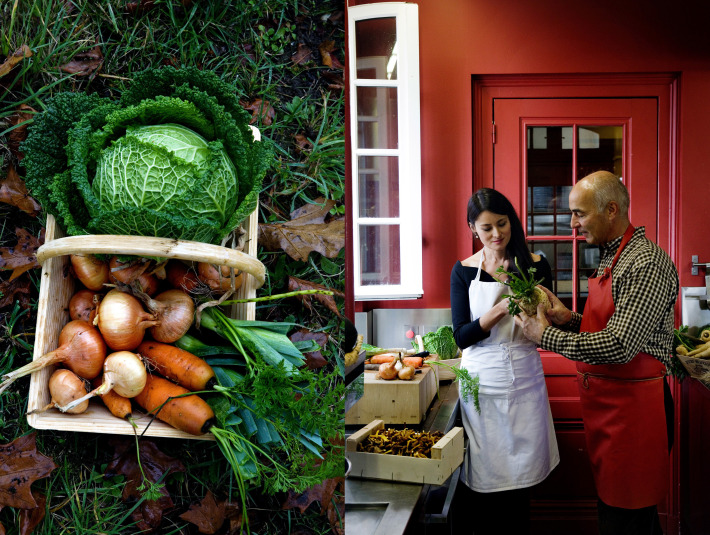
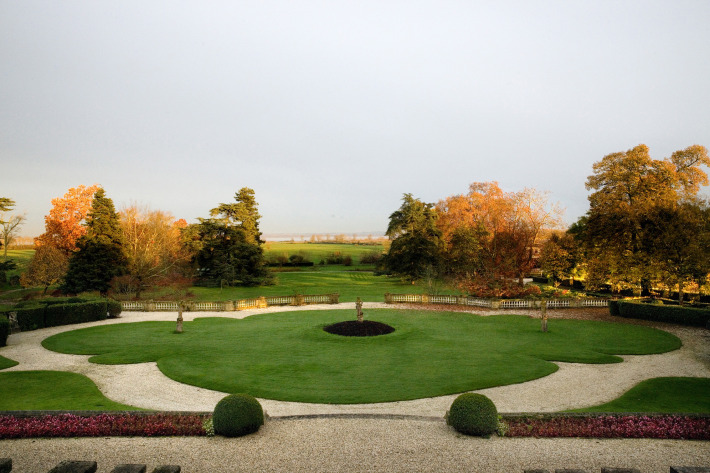
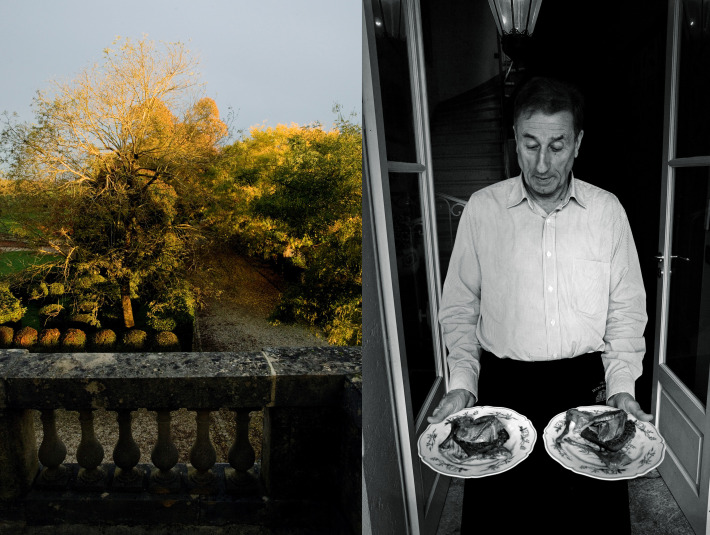
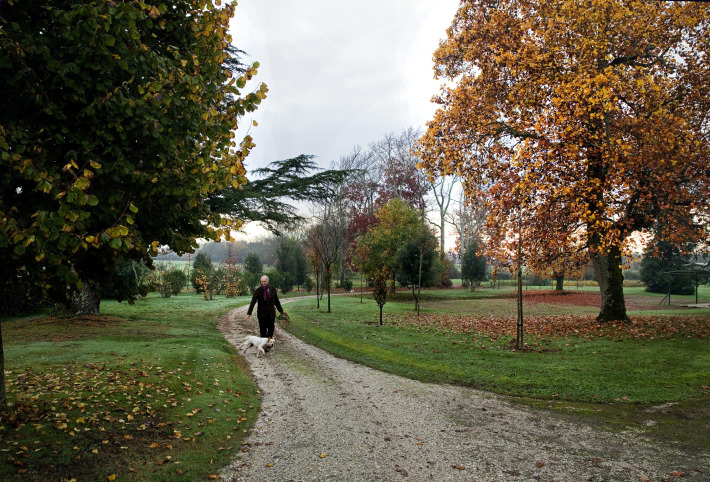

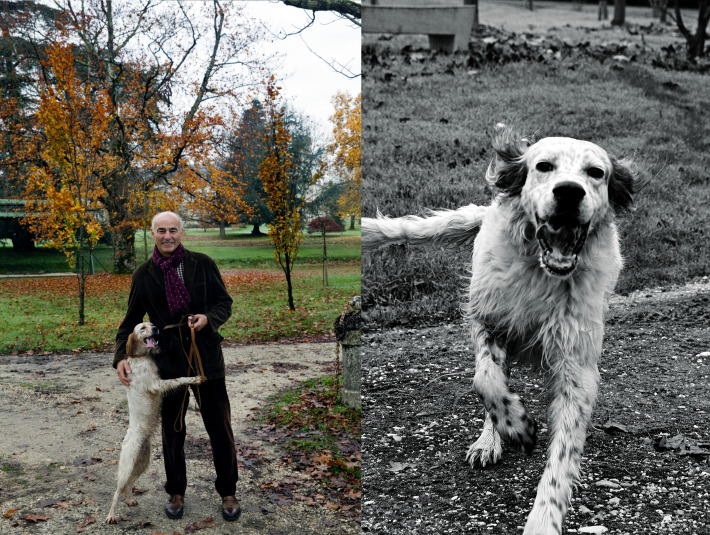
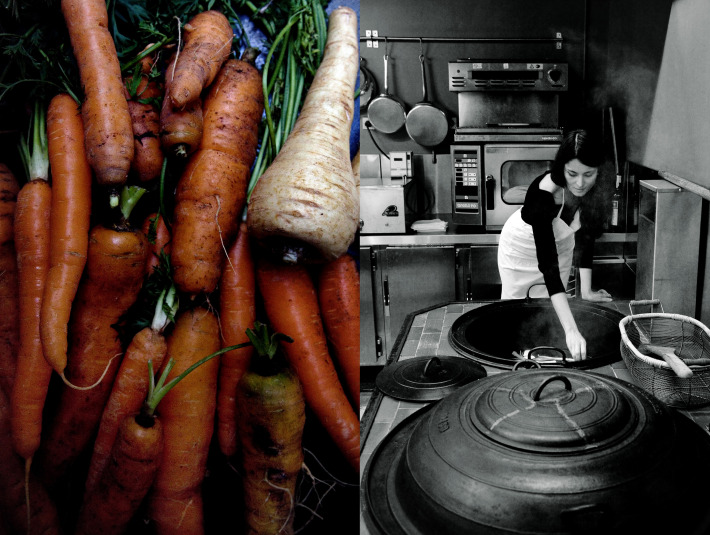
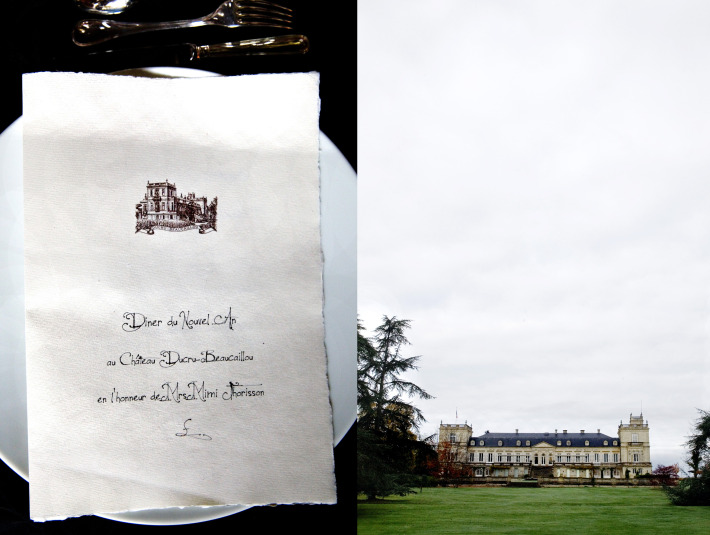
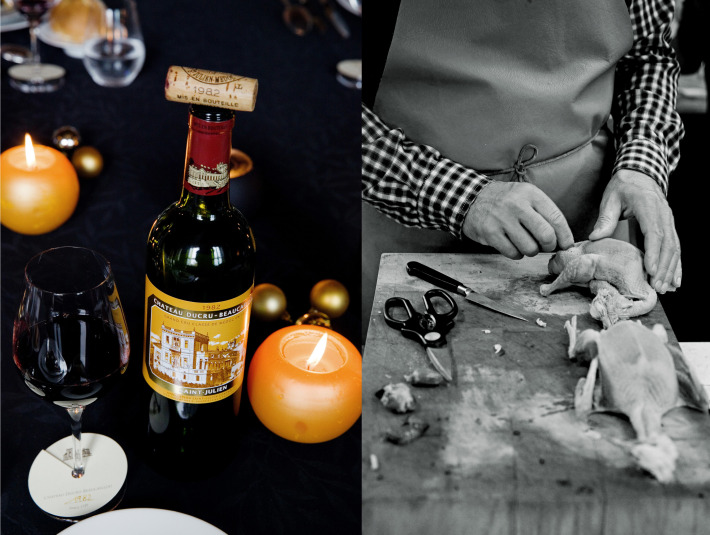
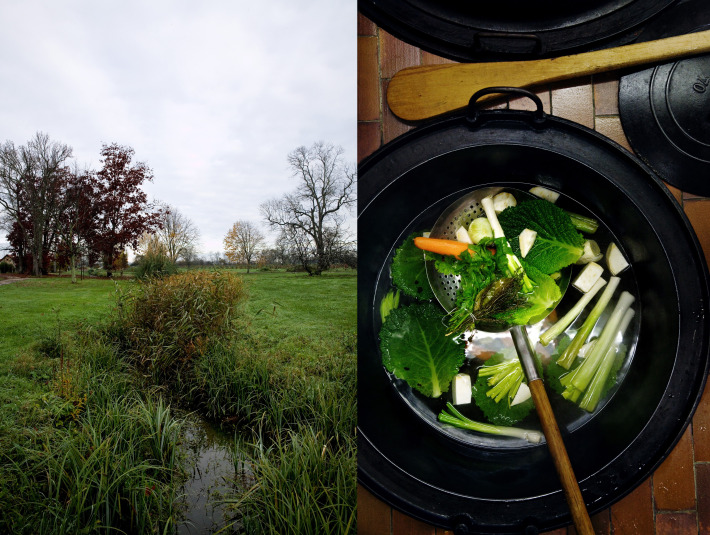
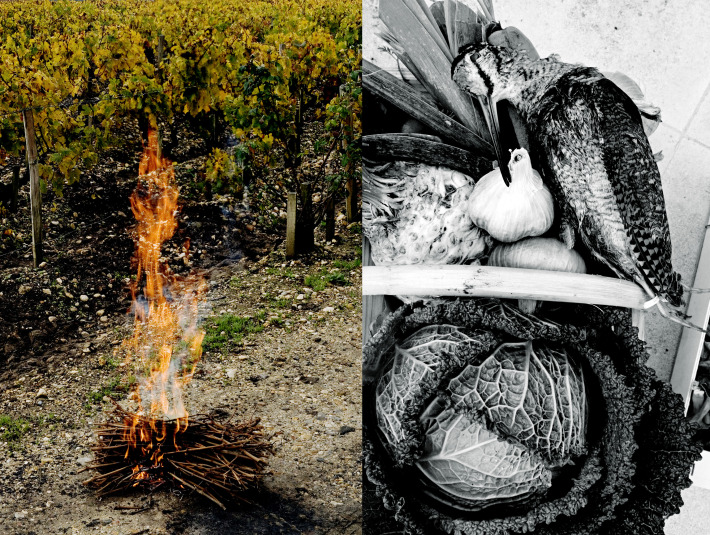
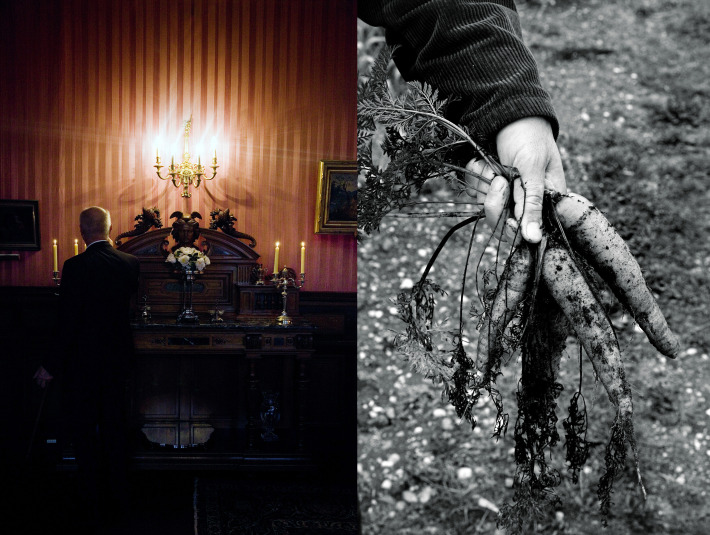
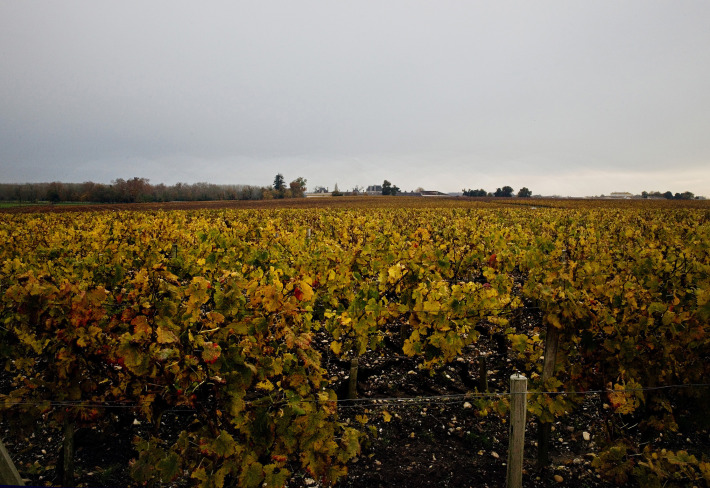
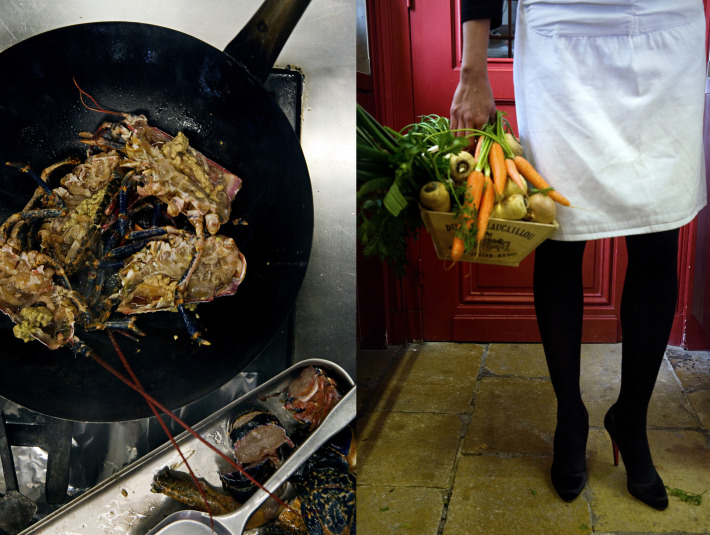
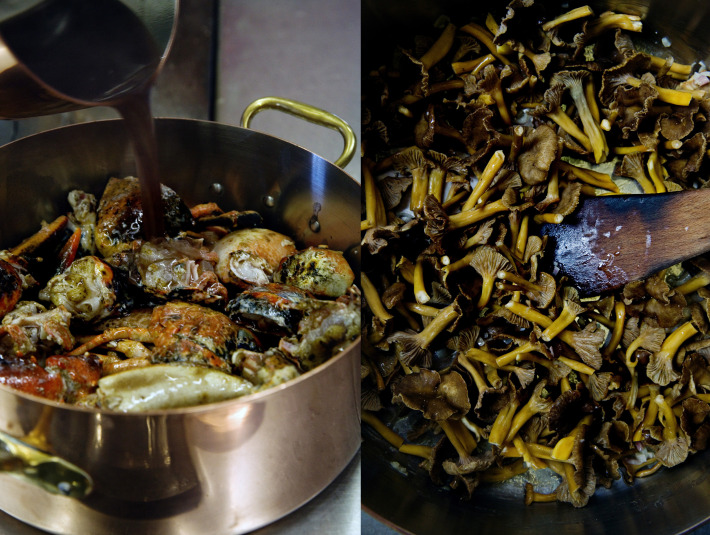
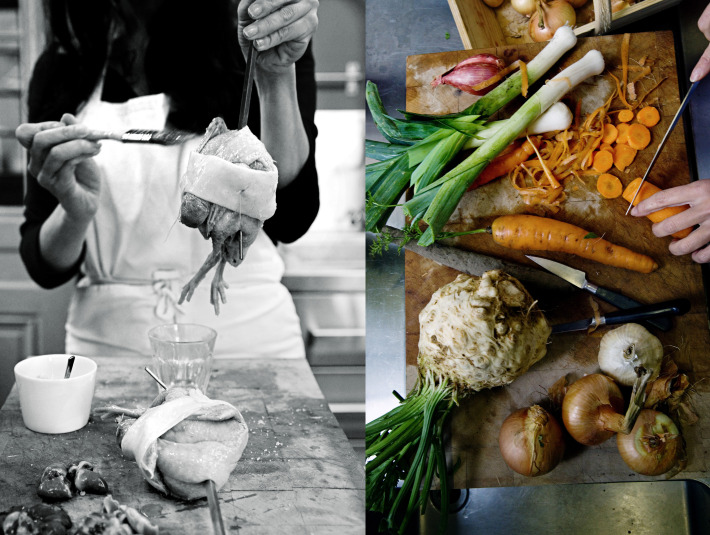
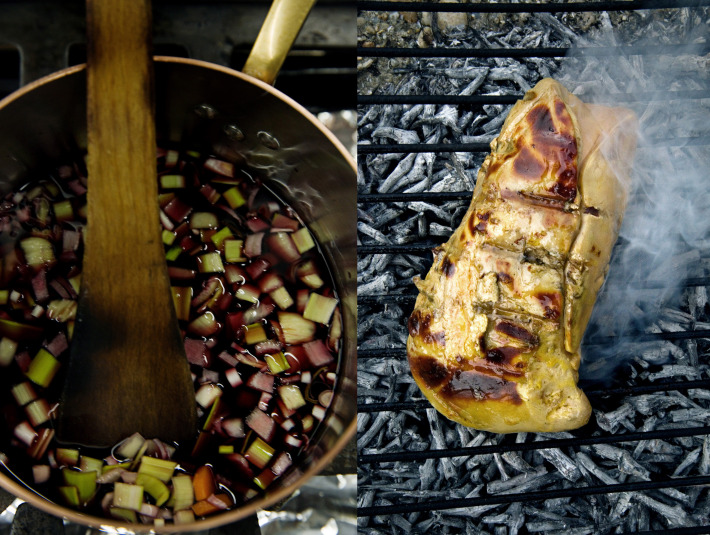
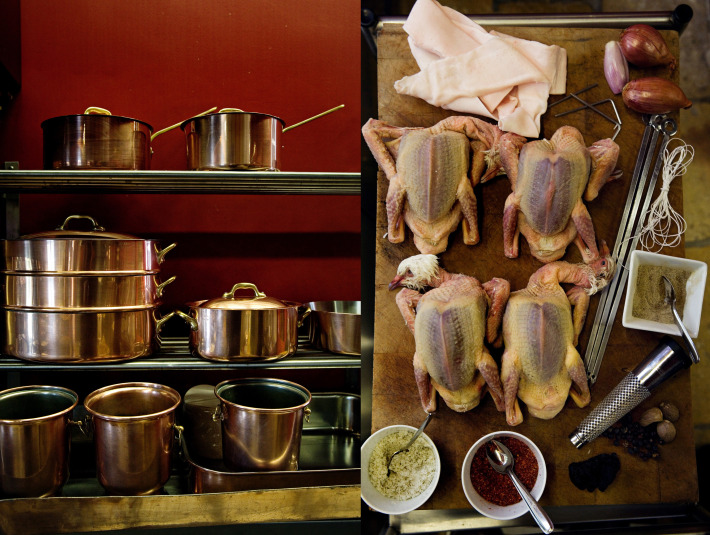
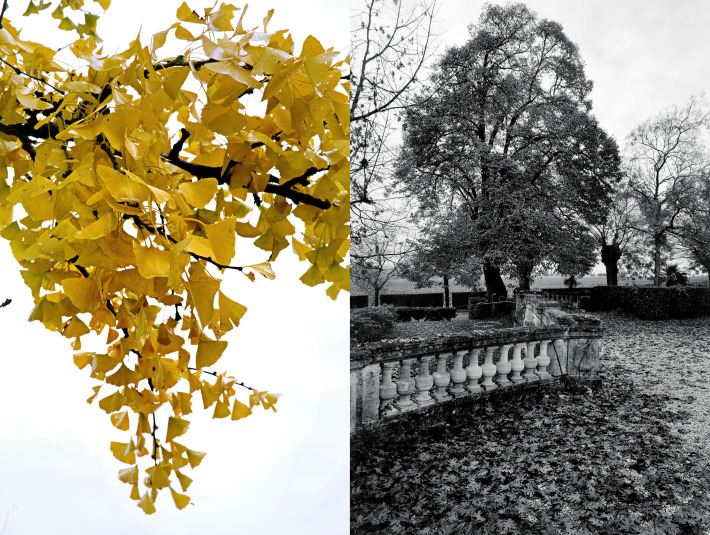
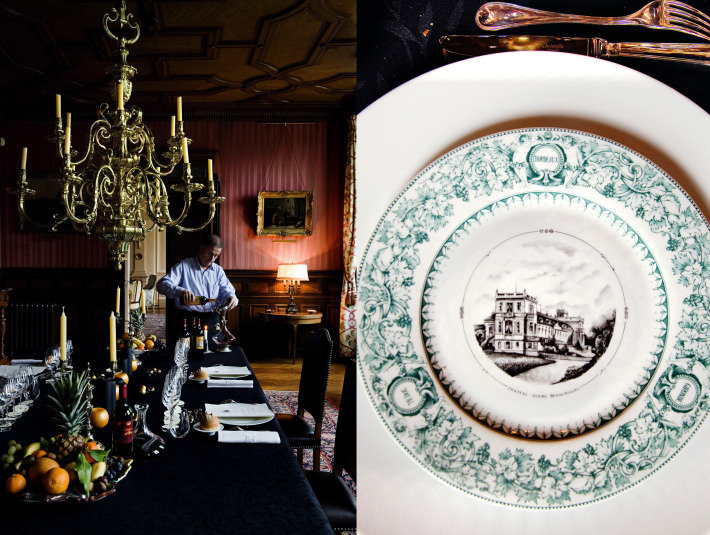
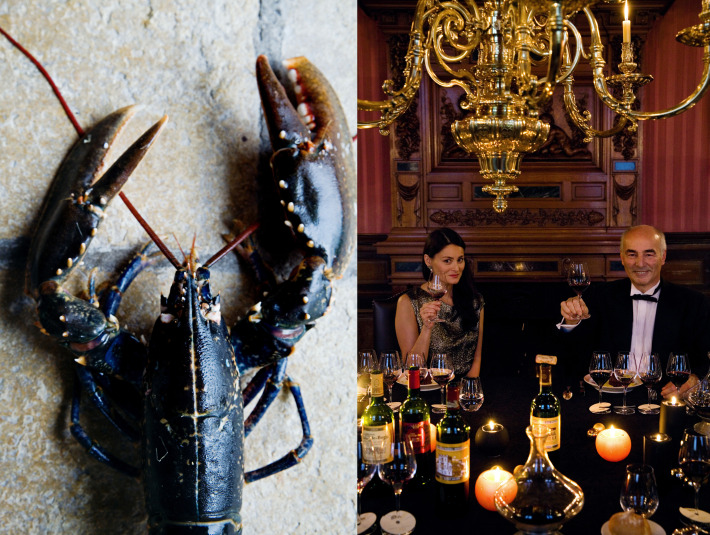
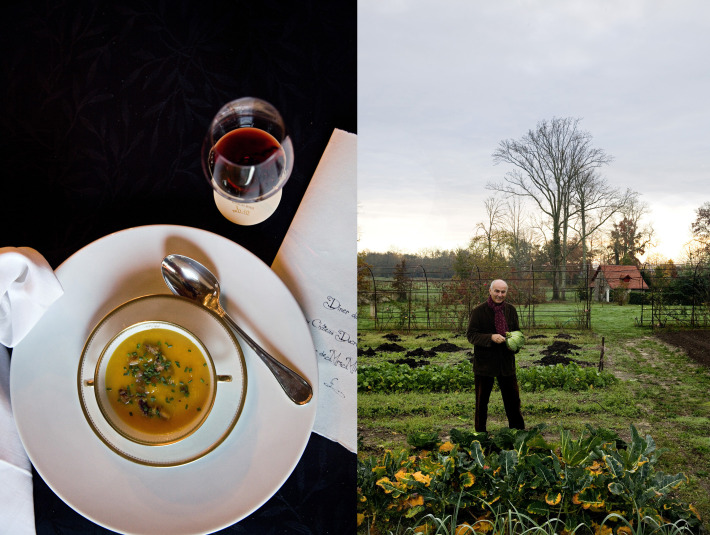
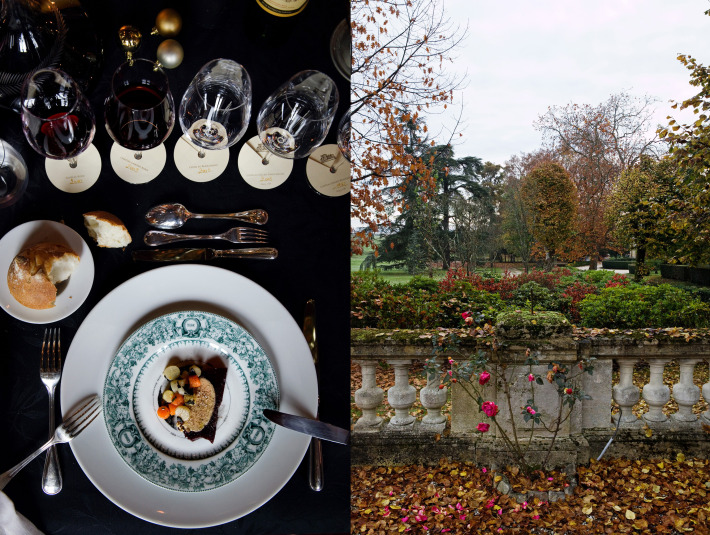
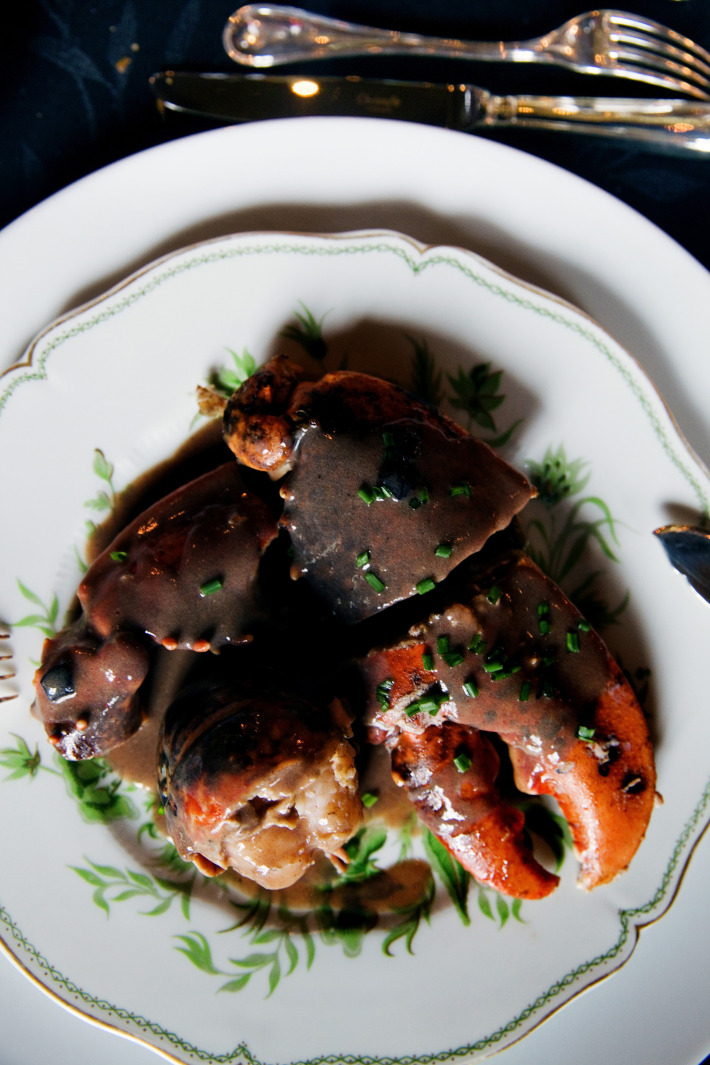
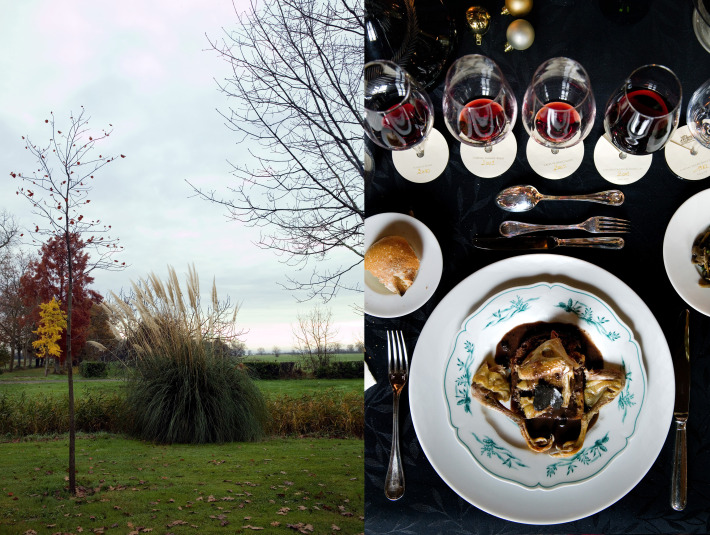
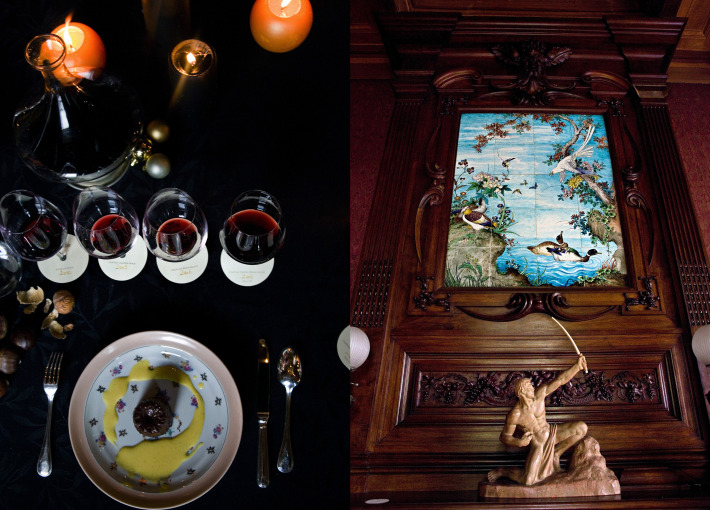
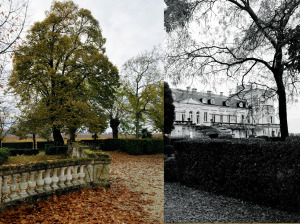
Magnifique comme d’habitude.Merci de mêler le beau et le bon, et de perpétuer la cuisine et l’art de vivre français.
Je suis surprise de trouver les recettes en français, quel bonheur! J’ai peut-être quelques trains de retard, du coup je vais jeter un oeil aux anciens post. Encore merci!
Merci Aude! J’ai eu la chance de cuisiner avec M. Borie, un chef si authentique et original! Régalez-vous avec ce menu festif, bonne fêtes! Mimi x
What a lovely surprise ! A menu for the New Year ! I hope to try them all during the holidays 🙂 Thank you Mimi !
Alice
So glad you liked it – trust me, it was delicious! You’ll have to try for the holidays! Enjoy, Mimi x
Dear Mimi,
Thank you so much for this new post!
I often pair pumpkin soup with chestnuts and foie gras, so festive! I just did it last friday with your parmentier de confer de canard for a party I hosted. Next time you’ll be invited…
This menu is so inspiring and exceptionnel… et en français!
Je suis ravie de t’avoir rencontrée samedi, c’était un vrai plaisir que j’aurai bien prolongé…
A bientôt,
belles fêtes de fin d’année,
xx Cécile
You are most welcome – It was such a special experience to cook with Bruno Borie – he is very inspiring and such a fabulous cook. Lovely seeing you on Saturday . Happy holidays, Mimix
What an amazing place, looks like it’s straight out of a fairy-tale. Amazing menu as well.
Thanks for sharing!
I agree, the château is really fairy-tale like. And so is the wine! One of Médoc’s finest! Enjoy the recipes. Happy holidays! Mimi x
ohmygoodness! ’nuff said.
thank you for sharing! xo sara
You are welcome! Enjoy the feast! Mimix
Wow! Outstanding job. I can see and tell all of the arduous work involved! I’ve never had the gift of eating pigeon before. Hope to some day : )
I so enjoyed cooking in this kitchen with Bruno – he is very inspiring as a chef! Pigeon is one of my favorite, you should definitely try. Mimi x
I absolutely love this menu (and the pictures that accompany each recipe). I think I might try the lobster stew for as part of my own New Years celebration menu this year!
And what an amazingly beautiful chateau to visit – I’m glad you were able to finally get into its kitchen. 🙂
Thank you Julia – this menu was a treat for the palate and the eyes! I hope this will inspire your festive dishes during this holiday season! Enjoy, Mimi x
Tres, très beau et inspirant.Pour trouver un peu l’esprit français pendant les jours festifs meme en Allemagne. Et pour moi la langue française est absolument nécessaire pour completer mon image de cette façon de vivre et cuisiner en France.
Merci beaucoup et j’espère a bientôt.
Joyeuses fetes, Isolde
Merci Isolde – ce festin est très inspirant! J’espère que vous allez essayer quelques unes de ces recettes, elles sont délicieuses. Bonnes fêtes! Mimi x
Quel endroit magnifique ! On dirait que les photos on était pris dans une conte ! Vous êtes tous les deux très élégants et le repas est sublime ! Une rêve !
C’est génial avoir traduire les recettes! Je veux essayer de faire le gâteau aux marrons !
Je te souhaite des très belles fêtes Mimi. J’en suis sure que vous avez beaucoup des choses à fêter ! Cet année, je passerais les fêtes à la campagne prés de Poitiers.
Joyeux Fêtes !! xo
Merci Eva – je cous souhaite de bonnes fêtes à Poitiers! Mmmmm, le gâteau aux chataîgnes était tellement bon, et très facile à faire! Mimi x
STUNNING.I am breathless from the visual tour. What an amazing menu and selection of wines.
I posted in another feed that you met my sister Kaaren Schilke Cherns and her husband and their Jack Russell Terrier DART on your recent book signing tour in NYC. I must tell you she was so excited to meet you and your husband and was able to send me the amazing pictures she took with you and your husband. Have a great Holiday Season.
Kat in Santa Fe, NM
Lovely to meet you Kat! Your sister Kaaren was so wonderful, and it was a great pleasure meetingher husband and Dart! So happy to hear you enjoyed this post – this is a special one. The wine, the history, the food – I couldn’t have been in a better place 🙂 Happy holidays, Mimi x
Hi Ladies!
So glad that you have been introduced to my New Mexican sister Mimi. She would have loved sitting at your table (in cowboy boots) chatting about wine pairings with Monsieur Borie & you. She is quite the oenophile & a person of expert knowledge concerning wines & spirits. She even makes her own beautiful Limoncello of the most stunning clarity. You would enjoy each other’s company indeed.
Cheers to you both & Merry Christmas!
Love,
Käären
The photos, the gradens, the architecture and the food–I’ve save this amazing post to reread quietly. So much beauty. And I am really getting hungry. Thank you.
Best wishes for a wonderful pre-Christmas season. Mary
What can I say, the château is a litle corner of paradise. Amazing wines, trees, the view… I hope you will try some of the recipes during the holidays! Be merry! Mimi x
Bonjour Mimi!
The braised cabbage is on my list to make!! Did Oddor get in formal attire also? This past weekend I made the creme fraiche roasted chicken, have purchased the ingredients for L’amie Jeans’ Parmesan soup. In two years I plan to visit you. Enjoying all things Mimi.
Can’t wait to meet you Andrea! We were all feeling festive that day! Enjoy the recipes. Happy holidays, Mimix
Un tout grand MERCI pour la traduction en français – un vrai bonheur!
Demain je vais faire vos gougères au Roquefort 🙂
Joyeuses fêtes de fin d’année, chère Mimi, xxx
Heureuse de partager les recettes en Français (merci Bruno!) et en Anglais! Et bonne dégustation, j’espère que vous allez aimer les gougères. Happy holidays, Mimi x
The perfect winter’s dinner, I am bookmarking this for New Year’s Day. Have a wonderful holiday! xx
Thanks Alison – this menu is coming from an extra-special kitchen! Happy holidays! Mimi x
You held my ATTENTION……….loved the paper with your name and the chateau….noticed your heels right away!The man and his TREES for his SON!What a gift!The FEAST……….the wine glasses,the table setting,the decor………all so splendid!I was right there with YOU all the way…………LUCKY YOU!XXX
Oh Contessa, this château is very “you” indeed! I was particularly touched by Bruno’s passion for the Médoc (he is a true Médocain gentleman), for nature, for food… you would like him! You’ll have to try the recipes! Wishing you a happy Christmas, Mimi x
Enchanting!
Thank you! Mimi x
Merci de toutes ces recettes elles vont me donner des idées pour les fêtes qui arrivent. Mille merci Mimi je vous suis depuis quasiment le début et chaque année c’est de mieux en mieux 🙂 Bonne chance pour la suite de votre aventure et qui sait je viendrai peut-être vous voir pour apprendre a cuisiner avec vous ….
Joyeuses fêtes.
Bonsoir Véronique! Merci pour votre gentilesse! J’ai beaucoup de chance d’être entourée par tant de personnes qui m’inspirent… Je vous souhaite de joyeuses fêtes! Mimi x
An absolutely marvelous post! One of your best, both in terms of the story and also the photos.
I am jealous of your opportunities to experience all of this!!!!
Oh thank you James! It’s wonderful to share this amazing cooking day! Happy holidays! Mimi x
stunning + a menu for New Years Eve! + I am excited. xxpeggybraswelldesign.com
Thank you Peggy! Enjoy the recipes! Happy holidays, Mimi x
Beautiful…always!! I feel like I’ve gone on vacation when I read your blog. Happy holidays. xo
Makes me so happy to hear you enjoyed this post – it was a lovely day, and stunning food & wine! Happy holidays! Mimi x
Merci pour la recette en français !
Toute la difficulté du blog est là pour nous petits français peu habitués à lire et comprendre l’anglais !
Encore bravo Mimi, vous êtes Magnifique!
Merci Maryelle, heureuse de pouvoir partager les recettes avec vous. Je vous souhaite de bonnes fêtes! Mimi x
Delightful post Mimi. Collaborative effort with Bruno sounds extra fun, but cooking without dogs!
Wonderful idea to use canele moulds in which to set your Grand-Mere’s recipe. I have copper, so will cross my fingers and hope! Any suggestions? Grease with butter and/or chestnut flour?
Bonsoir Jude! So happy to hear you enjoyed the post – such fun cooking with M. Borie! I actually tried making the chestnut recipe with copper coulds. It does work, you just have to grease with butter and plunge th ebase for a few second in hot water. Enjoy, they were soooo delicious! Mimi x
Mimi, thank you for the guidance. I am eager to try the chocolate/chestnut individual desserts, not only because they’re Gluten Free, but also to pay homage to a Grand-Mere. For many women of your generation, the joys of the disappearing art of real cooking have been rekindled by Grand-Meres. Bonne Annee Mimi, Oddur and family (including the dogs!).
How stunning! From the chateau to the menu. What an experience…thanks for bringing us along!
It certainly was a beautiful experience. I couldn’t be in better company for excellent food & wine! Happy holidays, Mimi x
Bruno Borie – what a wonderful name, and what an incredible chateau! Thank you for this treat of a meal Mimi, a joy to read and, as always, see through your husband’s photography. Your dress!!! I love it, you and Boris look magnificent! Also just to say I’m so so happy with your cookbook, I keep returning to it, especially now I’m nursing my 2 week old son (!!), sometimes to try a recipe, sometimes just for the stories (likewise I keep making your wonderful blinis and borscht – I love that December post so much and it will do us well for both Christmas eve and New Years). No wonder your book is such a hit – bravo Mimi!
Congrats Philippa! 2 wek old son? That is amazing! What a beautiful way to end the year, with a beautiful baby boy. Very touched to hear your kind words regarding the book, merci! Happy holidays! Mimi x
I always look forward to your stories and this one is one of the best! From the setting, the menu, your husband’s photos and the tale of how it happened…All stunning! Your life seems so magical, I wish all the very best for the holidays and may the New Year bring you as much joy (if not more) …
Thank you I am happy to hear you enjoyed this festive post! It is always a pleasure to share, especially at this tile of the year. I hope you will try some of the recipes! Mimi x
I haven’t read this post yet, I’ve still got loads of things to do before I can hit the sack tonight! And, with a week that looks to be getting more, not less, busy, I’m going to save this up for the weekend when I’ve got the time to properly take it all in but, I just wanted to say, aww – it’s nice to see the recipes in French, a sweet and pleasant surprise (even though that’s of no use to me – it’s a lovely touch). Merci Mimi.
Hi Susie! It’s the countdown until Christmas – woke up this morning and felt the clock ticking. I try my very best to to panic around Christmas time, instead, I just enjoy every little second, bake a lot, write more recipes, sip my Christmas tea! I hope you’ll try some of these recipes – trust me, they are good! 🙂 Happy holidays! Mimi x
I believe the appropriate French word would be “magnifique!” Gorgeous grounds and dining room, what a feast!
Silly Medley: Lifestyle and Travel
Merci Camille – a perfect menu for this festive season! Enjoy! Happy holidays! Mimi x
Wow, Mimi! This is the ultime experience. I love having the drawing of his “home” on the top of the menu.
Isn’t it elegant! Château Ducru-Beaucaillou is so beautiful! Happy holidays. Mimi x
Sounds like an absolutely ideal day!
I admire your bravery upon that first visit, irresistibly drawn to poke about. Your sense of adventure was well-rewarded. How magical to then become not just observer but participant of and in the red kitchen. Thank you for sharing the story and fabulous meal details. You looked stunning, as well. Cooking in heels, no less! Love love.
Oddir and I are quite fearless when it comes to exploring – we’ve got that adventurous spirits! Funnily, some of our best friendships and encounters have come from ‘semi’ trespassing 🙂 Enjoy the menu! Happy holidays, Mimi x
I am enchanted with this post and this menu! Bruno Borie is such an elegant man and together with you and the stunning photos….I feel as though I was there! We will be making this menu in NYC this holiday. A million thanks for transporting me to otherworldly places during the busy holiday season. It’s amazing to feel connectedness through food, nature and joy. Your cookbook is a treat and your Chou Farcie was a knockout!!!
You are welcome Lynn – Bruno was so kind to share his festive menu – this post is extra-special! Enjoy! Happy holidays, Mimi x
Wow. What a post.., day.., meal., experience..! My fiance (who is french) and I have been considering a move to france in the next couple of years. Your experience makes me want to book that plane ticket so much sooner. For now I will have to content myself with cooking a little more french in the kitchen, for which you have provided ample inspiration. Thank you & Merry Christmas
It’s a pleasure to share Nicola! You’ll have to come and visit us in Médoc 🙂 Merry Christmas! Mimi x
What an incredible feast & a rare treat (for us as well) although you got to gobble up your work.
Your Grandmother’s Chestnut Cake with custard looks verrry appealing. I currently have a bowl full of chestnuts waiting for me. Now there is a good excuse to purchase the silicone canelés mould I was considering after having the canelés at your book signing in NYC.
Bonjour Käären, It was nice to say hi to your sister yesterday! 🙂 Oh, Bruno’s grandmother’s cake was so delicious, so pure – I love it when you can taste all the fresh ingredients.This cake’s a winner, I hope you will enjoy it too! Happy holidays! Mimi x
Pity my invitation got lost in the post! Of course, I would have had to stay the night at the chateau after such a big, boozy feast, lol! Love that pooch – he looks just like my boy! Thanks for the lovely recipes again, Mimi. Happy holidays! X
I love this post, how many wonderful experiences and transmit us well, you make us really enjoy with your stories. You look very glamorous and is lovely. I will try some of your recipes, always successful in my home and among my friends.
I was delighted to see the photo of the yellow leaves of ginkgo biloba in my parents’ house in Galicia, there are also one and this Christmas will go there and enjoy it in its tone, in that area there are many chestnuts and I’ll try to make the chestnut cake her grandmother. A very big hug and thank you very much for bring us so much.
This is stunning, I adore the whole story and love how it all comes together in the end. What lovely photos and the meal is amazing. I can only imagine what a time you had.
I must do some reading on this gentleman and the Chateau.
I am also hoping Santa has placed your cookbook under my tree this year, I cannot wait to read it!
Un vrai régal comme chacun de vos posts , moment de délectation et ravie de trouver ce somptueux menu en français pour qui ( comme moi) est loin de maîtriser toutes les subtilités de la langue anglaise!
Dearest Mimi,
Amazing and delcious feast and beautiful words, Love.
Today is the best day of my life, it is my birthday, blessed and grateful. It started with an early morning beautiful bouquet from my husband, roses and orchids, and my princess illustrated a beautiful card, I am posting them on instgram.
Best wishes and much love .
Hi Mimi,
Wishing you and your family a blessed and wonderful Christmas
Best wishes xoxo
Querida Mimi , un post fascinante, elegante y sofisticado, me encantaria cocinar algunas de las recetas. Algunas son sencillas, pero otras las encuentro algo complicadas. Me encantaria saber algo de tu menú de Navidad….. Feliz Navidad para ti y todas las personas que amas. Rosa.
I cannot decide which I want more, the wine, the food, or a tour of the chateau! Everything is exquisite. That cake is seriously delectable sounding.
Gorgeous photos, Mimi!!! I’m speechless by them actually, as usual. 🙂 and those last pictures of you look like they belong on the cover of a suspense book or movie poster. Also…isn’t that how life goes? More often than not our plans don’t turn out the way we expect them to, but blessings that follow are always far better than our own plans!
Amazing holiday feast…enjoy creating your menu…I am sure you won’t disappoint! I am intrigued by the tree planting…would love to do that for my children…dreaming of a plot of land of our own if only for the trees! I’m going to give the gateau a shot…merci!
This tour and experiencing the making of this exquisite meal through your words and photos was absolutely decadent. Thank you for sharing.
Wonderfully rich and layered with gorgeous photos, as always, and I so enjoyed reading through the menu’s recipes. Utterly charming! But I must say it leaves me longing to see what you do in your Château. Looking forward. Have a wonderful Holiday and a Merry Christmas. Rié
Elegantly composed. Excitedly read. Captivating, evokes a time long past. Deliciously expressed and beautifully captured. Exquisite menu paired with fanciable attire. Monsieur Borie..enchanting and mysteriously gentle. In the end, one word, as the Scots first used the expression, WOW!
A magical Christmas filled with many blessings to you and your wonderful family. Merci, Merci!!
It’s wonderful to meet people you really admire, and in this case I can see why! What a place! All that history and you have two shared passions, the Medoc and food. No wonder you found each other. What a feast too. I’m mesmerised by all those glasses of wine. I think I might have to be airlifted out on a stretcher after five courses, but the food sounds and looks delicious. Dressing for dinner is the best, you look gorgeous. Xx
Oh Mimi,
This is just the decadence that a tired, over worked, New Balance wearing caterer needs to read. Magic!!!!
xx Anita
Bonjour Mimi! What an absolutely breathtaking estate!!! So elegant, beautiful, and mesmerizing!!! I can imagine how much enjoyment you had cooking and dining there!!! Happy Holidays!!! xoxo, dana
quelle magnificense ….merci Mimi pour ces belles pages . Vous nous donnez de l’envie . l’envie de se replonger dans un style de vie retrouvé avec art . Bravissima
I think it was all a beautiful fairy tale but then I couldn’t smell the pumpkin soup…
which I would make but I can’t get chestnuts in North Carolina…. maybe pecans?
Thankyou- what fun.
Pecans are a great idea, thanks!
Wow, the chestnut cake recipe seems extraordinary! A no-bake chestnut cake? It’s almost like a chocolate chestnut marzipan!
Fantastique festin! Je retrouve la recette des pigeons de mon grand-père.
Merci encore Mimi.
The Chestnut Chocolate cake made today for an overnight visit to Gambier Island tomorrow. It will not have the requisite 48 hours but it will have maybe 30 hours to compose itself.
I have never used fresh chestnuts prior to this undertaking and probably won’t again. (Except that I purchased two kilos of them and must use the other kilo soon.) What a lot of work to get them shelled and peeled! A note or warning would not go amiss that you can easily add one hour extra to the prep time. They did taste very nice and I am so looking forward to sharing this dessert with friends far, far away from Médoc. We will celebrate in a cabin, not a chateau.
Please tell M. Bruno “thank you” for sharing his grandmother’s recipe. I love his red kitchen.
It is always such a treat to read your blog – everything about it is beautiful.
Merry Christmas and Happy New Year.
Encore. The Chestnut Chocolate Cake of M. Borie’s grand-mere was *D*I*V*I*N*E*.
I served it with a scoop of ice cream plus a goodly dollop of caramel sauce laced with vanilla, lemon zest and juice.
The portions were small and perfect and very rich – so said everyone at the table.
They also said it was THE BEST DESSERT they had ever eaten. Certainly a great success.
Thank you and M. Borie very much.
The recipe made a very large portion so it will be the grand dessert tonight at the Christmas Eve feast.
Thanks to you and Bruno for sharing this delightful post. As always, I loved reading your story which lead to the mouth-watering recipes and beautiful photos which accompanied them.
The chateau looks fabulous, and I too would love a tour!
Merry Christmas, Mimi and best wishes for the happiest of New Years.
Merci beaucoup pour les recettes de ce festin en français.!
Tout semble délicieux!
Joyeuses fêtes
Christine
Just a quick follow up note to wish you and your beautiful family a very Merry Christmas and Happy Holidays! May your days be merry and bright… xxRié
Oh Mimi, you are wonderful! Your writing has so much enthusiasm in it, the attention to detail you bring to your posts, allows us to live vicariously through you from all parts of the world, regardless of local season. I am so happy for you that you had this phoenomenal experience! May you always have a choice between dinner and show, and having dinner as your show!!! Happy holidays and all the very best of everything to you and your beautiful family in the new year. Much love, Olga
Hi Mimi – Lovely blog!
Would you be able to educate us as to what the very large black cauldrons are? The ones you are leaning over, featured in photo #12? Are they wood fired? Very intrigued.
Thank you!
Hi Amy! Those are very big cast-iron pots, ideal for cooking harvest lunches and dinners for up to 50 to 60 people.And yes, they are wood-fired. They are amazing! One day, one day, I shall have one! 🙂
My son in law bought me your book for Christmas, and I am reading through it just as if it was a novel. I have just finished the Spring section, and will try some of those recipes when the ingredients appear at the market.
Lovely menu! Also, I just received the absolutely lovely print from the cookbook because f my pre-order. I received the very photograph I loved the most, the mélanges! I just know it medicated that 2015 will be a good year. I wanted to let you know how very pleased with the cookbook, and especially the print, I am. I will be taking it to be properly framed and then up it goes in the dining area. Thank you so much. Love your work. The best to you and your delightful family!
Auto correct drives me crazy. Sorry!
Hello Mimi, I’m really sorry but I never received the “affiche”. You told me recently that there was a problem ta thé impression but that I would receive it before Christmas. And I did’nt. So what can I expect now ? Have a lovely day !
Mimi, I just wanted to leave a quick note to say I received your book for Christmas and I adore it! PS this post is seriously making my mouth water …
Salud, Mimi,
Ma soeur m’a donné votre livre en guise de cadeau. Il est fort beau comme livre (félicitations à votre mari!), et vos narratives et vos recettes sont tellement belles.
Hier j’ai fait votre «garbure des Pyrénées». C’était magnifique. J’aime fort la bonne cuisine du sud-ouest de la France.
Je n’ai pas encore choisi un plat ou un menu pour le Réveillon de la Saint-Sylvestre. Je vais revisiter (*est-ce un mot en Français?») votre livre. Avez-vous des conseils?
Meilleures voeux (à vous, à Oddur, aux enfants, aux chiens . . .).
Bonne Année!
Pat
Ce post est tout à fait exceptionnel ! Cette semaine j’étais à Bordeaux et je pensais souvent à vous devant les étals du marché des Capucins, et aussi dans une grande brocante place St Michel où j’ai vu des jouets en bois géniaux pour les petites, j’ai dévoré votre livre qui me redonne envie de cuisiner, et ma fille a fait des plats si délicieux, je lui ai recommandé le blog. Je dois dire que je suis très admirative de la vitesse avec laquelle vous accomplissez vos rêves !!! L’impatience du bélier qui n’attend pas ! Très belle année à vous dans votre nouveau sweet home !
Received the cookbook for Christmas. Wow! The photography is stunning, can’t wait to try the recipes. The nicest surprise is how well written it is. Great job! I want to go to Medoc.
Mimi- I thought of you when I saw the website of a couple restoring a chateau… I think you will see some similarities!
http://www.chateaudegudanes.org/
Dear Mimi, Just read your latest post and enjoyed every minute of your celebration! Received your cookbook from my son this Christmas! I immediately sat down and started reading it all! Thanks for sharing your recipes and adventures. Bonnie
Beautiful Photos! Beautiful Food!
lipsticksandwich.com
When I turned 21, a boyfriend took me to Daniel, in New York City, for dinner. It was the first time I had ever been to a four-star restaurant, and he splurged on a bottle of Ducru-Beaucaillou. A few years later, I recounted that special evening to a couple I had met in a restaurant with my father (mu father and I began talking to them about food and they invited me back to their glorious apartment to keep talking!). I was working then, as a journalist, and living “simply.” When I talked about the wine, they took me into their wine cellar and gave me a bottle of . . . you guessed it. A 1982 Ducru-Beaucaillou! They insisted I take it. I saved it for my 30th birthday. Mimi, I just gave myself the gift of your cookbook, and this summer, on my 50th (I am getting far too old!) I am taking my children to France so we can live simply for a few weeks and I can cook and finally, finally work on my awful French. This post of yours is an early gift: it is inspiring for what lies ahead and reminds me of the pleasure I’ve had sharing very special bottles and great meals with people I’ve loved or just met (food and wine unites us, no?). Merci!
Thank you Leslie for sharing such a beautiful story! I am so happy to hear you will be coming to France for a holiday… why don’t you visit the Château Ducru-Beaucaillou? I mean, it will be your birthday!:) Happy new year, Mimi x
Dear Mimi,
I have recieved your beautiful cook book for Christmas and I am reading it like a novel. Thank you so much
Barbara
Thank you Barbara! I am so touched, Mimi x
[…] White Pumpkin Soup with Roasted Chestnuts Adapted from Manger […]
What a meticulously prepared post. From my perch in coastal Georgia, I never expected this blog to transport me to France – but it surely did! So glad to find you through Quintessence & Stacy.
Thank you Jayne – it’s a pleasure sharing our culinary adventures! A bientôt! Mimix
I host a wine tasting twice a year with a Sommelier and his wine-knowlegeable partner. They choose the wines based on a theme. We usually sample six whites and six reds. We provide food and I usually make a dessert.
The upcoming tasting will be on March 8 which is International Women’s Day. I will make M. Borie’s Grand-Mère’s chestnut and chocolate cake as it was such a hit over the Christmas holidays and to honour women.
My question to you is: which wine did M. Borie serve for dessert at the magnificent dinner you had with him? I want to make sure that we have the best combination.
Merci
nice looking meals. vegetables are very fresh. sri lankan food and your food recipes are different. it is very testy looking. i like this meals and cooking style.
[…] may recall a post on this blog from last December where I visited Château Ducru Beaucaillou and cooked with the owner Mr. Bruno […]